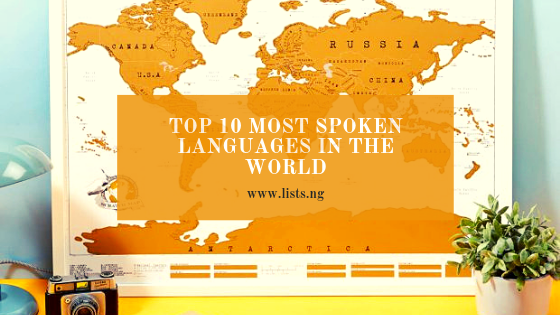According to Ethnologue language database, there are over 7,000 unique languages spoken all over the world. These languages are distinctively unique to different groups and completely alien to others.
Some languages however have gained prominence around the world. Whether as a result or early conquests or recent globalisation, these languages have spread rapidly and have been integrated into diverse peoples and cultures.
Below are the world’s most spoken languages by total number of speakers.
1. English
Total Number of Speakers: 1.132 billion
English as it is today developed from several linguistic influences, these influences came from the languages of Germanic tribes, Normans, Celts and Vikings. Britain, however carried out the duty of spreading the language through its many conquests, interactions and trade with the rest of the world. Today, English has become the primary native language of states such as the United States, Canada, the United Kingdom, Ireland, Nigeria, Australia, Namibia, among others. Today, around 1.132 billion people in the world speak English language up to some level.
2. Mandarin Chinese
Total Number of Speakers: 1.116 billion
Chinese Mandarin is part of the Sino-Tibetan linguistic family which stretches across much of Asia. The language consists of a number of dialects, which can vary considerably from one another. The language consists of a number of dialects, which can vary considerably from one another. Asides from China, which is its origin, Chinese Mandarin is also widely spoken in Taiwan, Singapore, and Malaysia. In order to make the language easy to learn, the Chinese government in the 1950s initiated a system of writing in simplified characters while still keeping the traditional characters.
3. Hindi
Total Number of Speakers: 615.4 million
The History of the Hindi language can be traced to Sanskrit, an early language spoken by Aryan settlers in northwest India. Over the centuries, Hindu was influenced by Dravidian, Turkic, Portuguese, Persian, Arabic, and English. Hindi is presently modern Indo-Aryan Language and has become the dominant language in India, and it is also spoken in Nepal, US, South Africa, Yemen, and Mauritius.
4. Spanish
Total Number of Speakers: 534.3 million
Spanish is the official language in Spain and numerous Latin-American countries such as Argentina, El Salvador, Chile, Mexico, Guatemala, and Costa Rica. Spanish is a part of the Ibero-Romance group of languages, which evolved from several dialects of Vulgar Latin in Iberia after the collapse of the Western Roman Empire in the 5th century. Spanish has also been influenced by other languages. Around 75% of modern Spanish vocabulary is derived from Latin, including Latin borrowings from Ancient Greek, and around 8% have been influenced by Arabic during the Al-Andalus era in the Iberian Peninsula.
5. French
Total Number of Speakers: 279.8 million
French is a Romance language of the Indo-European family. It descended from the Vulgar Latin of the Roman Empire. As a result of French and Belgian colonialism from the 16th century onward, French was introduced to new territories in the Americas, Africa and Asia. Most second-language speakers reside in Francophone Africa, in particular Gabon, Algeria, Morocco, Tunisia, Mauritius, Senegal and Ivory Coast. French is an official language in 29 countries across multiple different continents, most of which are members of the Organisation internationale de la Francophonie (OIF), the community of 84 countries which share the official use or teaching of French.
6. Standard Arabic
Total Number of Speakers: 273.9 million
Modern Standard Arabic, also known as Literary Arabic was developed in the early part of the 19th century and is the literary standard across the Middle East, North Africa and Horn of Africa, and is one of the six official languages of the United Nations. Modern Standard Arabic is the official language of all Arab League countries and is the only form of Arabic taught in schools at all stages. More so, most printed material by the Arab League—including most books, newspapers, magazines, official documents, and reading primers for small children—is written in Modern Standard Arabic.
7. Bengali
Total Number of Speakers: 265.0 million
Bengali is an Indo-Aryan language which descended from the Sanskrit and Magadhi Prakrit dialects primarily spoken by the Bengalis in South Asia. Bengali literature, with its millennium-old literary history, has extensively developed since the Bengali Renaissance and is one of the most prominent and diverse literary traditions in Asia. Bengali is the official language in Bangladesh, and it is widely spoken in India, and Sierra Leone as well as in the UK, the US, and the Middle East.
8. Russian
Total Number of Speakers: 258.2 million
Russian is an East Slavic language of the Indo-European linguistic family. Russian developed from the Polanian dialect, which is official in the Russian Federation, Belarus, Kazakhstan and Kyrgyzstan, as well as being widely used throughout Eastern Europe, the Baltic states, the Caucasus and Central Asia. It was the de facto language of the Soviet Union until its dissolution on 25 December 1991. Russian is still being used in official capacity or in public life in all the post-Soviet nation-states, three decades after the collapse.
9. Portuguese
Total Number of Speakers: 234.1 million
Portuguese is a Western Romance language originating in the Iberian Peninsula. It is the sole official language of Portugal, Brazil, Cape Verde, Guinea-Bissau, Mozambique, Angola, and São Tomé and Príncipe. It also has co-official language status in East Timor, Equatorial Guinea and Macau in China.
10. Indonesian
Total Number of Speakers: 198.7 million
Indonesian is the official language of Indonesia, the fourth most populous nation in the world. Of its large population, the majority speak Indonesian, making it one of the most widely spoken languages in the world. For centuries, It is has been used as a lingua franca in the multilingual Indonesian archipelago.



